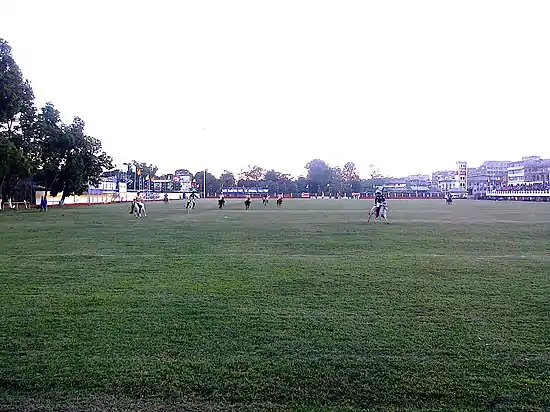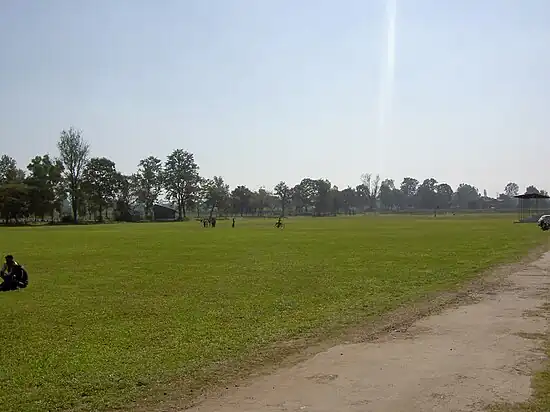Origin of Polo
About various theories of the birth place of polo
Despite innumerable claims from various nations and kingdoms for the origin place of the world famous game of polo, Ancient Manipur has the earliest history of the sports, right from 3100 BC.[1][2][3] Next to it, the earliest history is followed by that of Persia in 525 BC.[1]


The fact that Manipur is the birth place of polo is already supported by the Guinness World Records, by a declaration in the year 1991, as:
"Polo can be traced to origins in Manipur state c. 3100 BC, when it was played as Sagol Kangjei."
_Guinness World Records, 1991, page no. 706.[1]

Notably, it is worth mentioning that the Imphal Polo Ground is the oldest polo ground in the world.[4][5][6][7][8]
History
 The game of polo (Sagol Kangjei) was invented during the reign of King Kangba (1405 BC-1359BC), the successor of Tangja Leela Pakhangba.[9] This remarkable achievement was recorded in many ancient scriptures including the Kangbalon and the Kangjeirol.[9]
The game of polo (Sagol Kangjei) was invented during the reign of King Kangba (1405 BC-1359BC), the successor of Tangja Leela Pakhangba.[9] This remarkable achievement was recorded in many ancient scriptures including the Kangbalon and the Kangjeirol.[9]

Mythology
Marjing, the deity invented the game of polo according to Meitei mythology (Manipuri mythology). He rides on Samadon Ayangba, the flying winged horse, created by Sanamahi, from the moon land. It is Marjing, who laid on the rules and regulations for the game of polo according to Meitei religion (Sanamahism). Interestingly, it is notable that Marjing is the only god in the world, who is associated with the polo. No other religions of the world have the god of polo except Meitei religion.[10][10][11][12][13]
Acclamation
The International Museum of the Horse unveiled an exhibition on Manipur's history of polo and polo pony, in the Kentucky Horse Park, in Lexington, USA.[14]
Controversies and debates
After continuous debates regarding the origin of the polo, an Italian author Fulvio Cinquinni settled the doubt once and for all. For these, he visited Imphal to collect adequate historical documents and materials for book on the game.[15]
References
- "Sportstract.com". www.sportstract.com. Retrieved 2022-03-05.
- Dhar, Aatreyee (2021-07-01). "The Game Of Polo Was Born In Manipur Before The Britishers Influenced It". ED Times | Youth Media Channel. Retrieved 2022-03-05.
- "Manipuri Polo". e-pao.net. Retrieved 2022-03-05.
- Bahl, Ananya (2020-03-09). "Manipur the birthplace of modern polo is home to a formidable women's team". The Hindu. ISSN 0971-751X. Retrieved 2022-03-05.
- "Polo Ground, Imphal". www.nativeplanet.com. Retrieved 2022-03-05.
- "Exploring The World's Oldest Polo Ground - Sportz Talk". 2022-01-05. Retrieved 2022-03-05.
- "Manipur: The place where polo was born?". Hindustan Times. 2014-12-21. Retrieved 2022-03-05.
- "Exploring the World's Oldest Polo Ground". WorldAtlas. 2019-03-25. Retrieved 2022-03-05.
- "SAGOL-KANGJEI". themanipurpage.tripod.com. Retrieved 2022-03-05.
- Mārg̲. Marg Publications. 1960.
- Lightfoot, Louise (1958). Dance-rituals of Manipur, India: An Introduction to "Meitei Jagoi". Ministry of Scientific Research and Cultural Affairs. ISBN 978-1-01-374640-6.
- Anvīkshā. Jadavpur University. 2004.
- Singh, Moirangthem Kirti (1988). Religion and Culture of Manipur. Manas Publications. ISBN 978-81-7049-021-0.
- Nov 21, TNN / Updated; 2012; Ist, 14:11. "US museum unveils exhibit on Manipur polo history | Guwahati News - Times of India". The Times of India. Retrieved 2022-03-05.
{{cite web}}: CS1 maint: numeric names: authors list (link) - "Italian seal on Manipur polo origin - Milan-based writer to visit Imphal to collect material for book on game's history". www.telegraphindia.com. Retrieved 2022-03-05.